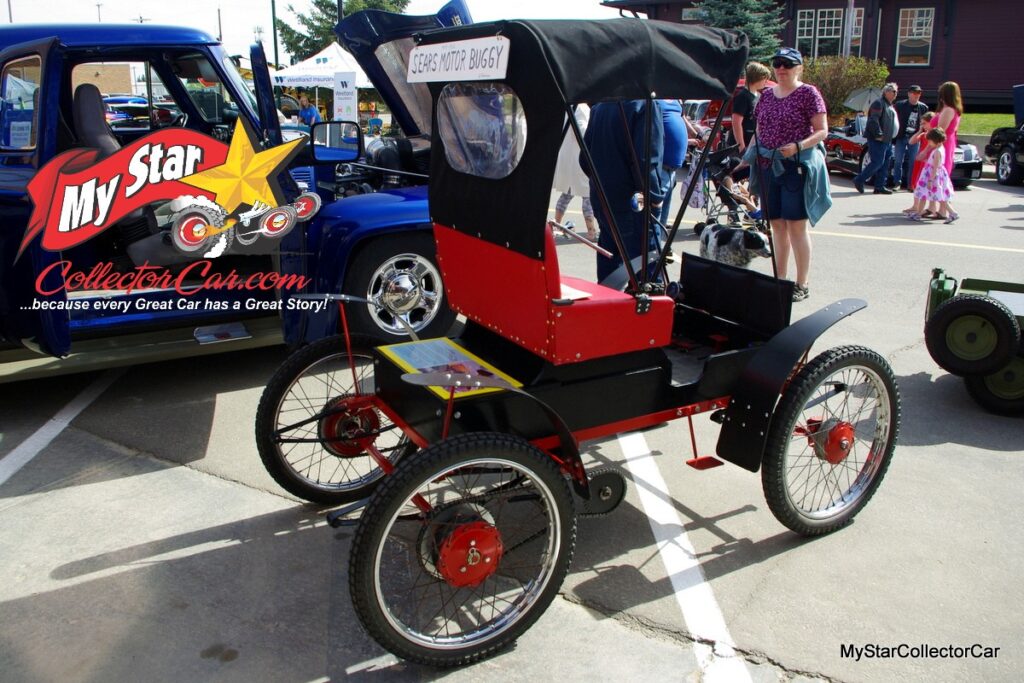You won’t see many 1909 Sears Motor Buggys at car shows.
That’s why this ¾ scale tribute was such an important history lesson.
Garry Anderson built this tribute because he thought the best way to show automotive history was to offer a rolling tribute, so the public could learn about the Sears Motor Buggy.
Jerry Sutherland
Sears, Roebuck & Co. entered the car retail world in 1908 with the high-wheel runabout Motor Buggy. They placed it in their Fall catalog and sold it for $395.00. That meant it was half the price of a brand new 1909 Ford Model T.
The Motor Buggy was designed by an engineer named Alvaro S. Krotz. He sold Sears on the idea of marketing these cars through their catalogs, so the Motor Buggy was born.
The Motor Buggys were factory-built, made from various parts and powered by a 10-horsepower, two-cylinder, horizontally opposed engine. They had a friction-drive transmission, solid rubber tires and wooden-spoke wheels.
They also had tiller steering because horse and buggies were still in the mix, so the tiller system was more familiar to buggy drivers—and cheaper than a steering wheel. They came in a crate and all the buyers had to do was attach the wheels—Sears magic at its finest.
Sears added upgrades every year—things like fenders, tops, running boards and tires with air. They even dropped the price, but after five years they’d only sold 3500 Motor Buggys. That’s when the money guys at Sears threw a flag on the Motor Buggy and it disappeared from the catalog.
Garry knew this history and he also knew it was impossible to find a Motor Buggy, so he did the next best thing and built one. He used the dimensions from the book on these cars and simply scaled it down to ¾ scale. Garry wanted to capture the spirit of a Motor Buggy in a realistic package.
He built the car over one winter because these are very basic vehicles–plus Garry has a truckload of talent. Garry went with a 24-volt electric motor because that made the most sense—he was essentially building a cool golf cart.
The controls are simple. There are three pedals for the brake, reverse and forward so this is a basic setup. The accelerator is found on the tiller, so the driver gets the full original Motor Buggy experience with modern touches. Garry added a functioning speedometer from 1910, so this retro Motor Buggy has period-correct equipment.
This Motor Buggy is not just a display for car shows because Garry drives it regularly. He lives in a small town where he can do routine trips without getting on high-speed roads. Garry runs it at 8-9 miles per hour because that’s a realistic pace for what he built and Gary’s a practical guy.
Some guys like to study history, but car guys prefer to live history—there’s a big difference between the two concepts.
Fortunately, Garry Anderson prefers to showcase history—that’s why he built this piece of automotive folklore.
Jerry Sutherland
By: Jerry Sutherland
Jerry Sutherland is a veteran automotive writer with a primary focus on the collector car hobby. His work has been published in many outlets and publications, including the National Post, Calgary Herald, Edmonton Journal, Ottawa Citizen, Montreal Gazette, Saskatoon StarPhoenix, Regina Leader-Post, Vancouver Sun and The Truth About Cars. He is also a regular contributor to Auto Roundup Publications.
- CLICK HERE TO SIGN UP FOR THE NEWSLETTER
- CLICK HERE to Like us on Facebook
- CLICK HERE to Follow us on Twitter
- CLICK HERE to Follow us on Pinterest
